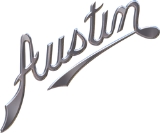
Austin Motor Company
Encyclopedia
The Austin Motor Company was a British manufacturer of automobiles. The company was founded in 1905 and merged in 1952 into the British Motor Corporation
Ltd. The marque Austin was used until 1987. The trademark is currently owned by SAIC after being transferred from bankrupt subsidiary Nanjing Automotive.
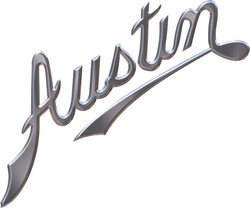
(1866–1941), former manager of the Wolseley Tool and Motor Car Company
, and later to be made first Baron Austin of Longbridge, founded The Austin Motor Company in 1905, at Longbridge
, which was then in Worcestershire
. (Longbridge became part of Birmingham
in 1911 when its boundaries were expanded.) The first car was a conventional 5-litre four-cylinder model with chain drive, of which about 200 were made in the first five years. In World War I Austin grew enormously in fulfilling government contracts for everything from artillery to aircraft, and the workforce expanded from around 2,500 to 22,000.
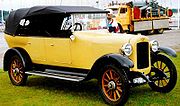
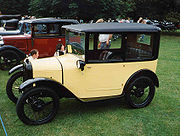
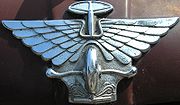 After the war Herbert Austin decided on a one-model policy based on the 3620 cc 20 hp engine. Versions included cars, commercials and even a tractor, but sales volumes were never enough to fill the vast factory built during wartime. The company went into receivership
After the war Herbert Austin decided on a one-model policy based on the 3620 cc 20 hp engine. Versions included cars, commercials and even a tractor, but sales volumes were never enough to fill the vast factory built during wartime. The company went into receivership
in 1921 but rose again after financial restructuring.
Critical to the recovery was the appointment in 1922 of a new finance director, Ernest Payton with the backing of the Midland Bank
, and a new works director in charge of car production, Carl Engelbach, at the insistence of the creditors' committee. This triumvirate of Austin, Payton and Engelbach steered the company's fortunes through the inter-war years.
In a quest to expand market share, smaller cars were introduced, the 1661 cc Twelve in 1922 and, later the same year, the Seven
, an inexpensive, simple small car and one of the earliest to be directed at a mass market. One of the reasons for a market demand for a cars like the Austin 7 was the British tax code. In 1930 every personal car was taxed by the engine size, which in American dollars was $2.55 per square inch of piston displacement. As an example the owner of an Austin 7 in England which sold for approximately $455.00 would had to pay a yearly engine tax of $39.00. In comparison the owner in England of a Ford Model-A would have to pay $120.00 per year in an engine tax. And this system of engine displacement tax was common in other European nations as well in the 1930s. At one point, the "Baby Austin" was built under licence by the fledgling BMW
of Germany (as the Dixi
); by the Japanese manufacturer Datsun
; as the Bantam
in the United States; and as the Rosengart
in France. And in England the Austin was the most produced car in 1930 (the American Austin Car Company
operated as a largely independent subsidiary from 1929 to 1934, and was revived under the name "American Bantam" from 1937 to 1941).
With the help of the Seven, Austin weathered the worst of the depression and remained profitable through the 1930s, producing a wider range of cars which was steadily updated by the introduction of all-steel bodies, Girling brakes, and synchromesh gearboxes. However, all the engines retained the same side-valve conformation. Deputy chairman Ernest Payton became chairman in 1941 on the death of Lord Herbert Austin. In 1938 Leonard Lord
joined the company board and became chairman in 1946 on the death of Ernest Payton.


, better known as the Dambusters.
The postwar car range was announced in 1944 and production of it started in 1945
The immediate postwar range was mainly similar to that of the late 1930s but did include the 16 hp significant for having the company's first overhead valve
engine.
In 1952 Austin merged with the Nuffield Organisation
(parent company of Morris) to form the British Motor Corporation
with Leonard Lord in charge. Austin was the dominant partner and its engines were adopted for most of the cars; various models amongst the marques would soon be badge-engineered
versions of each other.
Also in 1952, Austin did a deal with Donald Healey, the renowned automotive engineer. It led to a new marque, Austin-Healey
, and a range of sports cars.
of Japan, for that company to assemble 2000 imported Austins from partially assembled sets and to sell them in Japan under the Austin trademark. The agreement called for Nissan to make all Austin parts locally within three years, a goal Nissan met. Nissan produced and marketed Austins for seven years. The agreement also gave Nissan rights to use Austin patents, which Nissan used in developing its own engines for its Datsun
line of cars. In 1953 British-built Austins were assembled and sold, but by 1955, the Austin A50 – completely built by Nissan and featuring a slightly larger body with 1489 cc engine – was on the market in Japan. Nissan produced 20,855 Austins from 1953–59.
 With the threat to fuel supplies resulting from the 1956 Suez Crisis
With the threat to fuel supplies resulting from the 1956 Suez Crisis
Lord asked Alec Issigonis
to design a small car and the result was the revolutionary Mini
, launched in 1959. The Austin version was called the Austin Seven at first. But Morris' Mini Minor name caught the public imagination and the Morris version outsold its Austin twin, so the Austin's name was changed to Mini to follow suit. In 1970, British Leyland dropped the separate Austin and Morris branding of the Mini. From then, it was simply "Mini", under the Austin Morris division of BLMC.
The principle of a transverse engine with gearbox in the sump and driving the front wheels was carried on to larger cars with the 1100 of 1963, (although the Morris-badged version was launched 13 months earlier than the Austin, in August 1962), the 1800
of 1964 and the Maxi
of 1969. This meant that BMC had spent 10 years developing a new range of front-drive, transverse-engined models, while most competitors had only just started to make such changes.
The big exception to this was the Austin 3-litre
. Launched in 1968, it was a rear-wheel drive large car, but it shared the central section of the 1800. It was a sales disaster, with fewer than 10,000 examples being made.
But BMC was the first British manufacturer to move into front-wheel drive so comprehensively. Ford
did not launch its first front-drive model until 1976(in Britain, Ford-Germany in 1962 with the Taunus 12M(P4)), while Vauxhall's
first front-drive model was launched in 1979 and Chrysler UK's
first such car was launched in 1975. Front-wheel drive was popular elsewhere in Europe, however, with Renault
, Citroen
and Simca
all using the system at the same time or before BMC.
In 1966, BMC and Pressed Steel
merged with Jaguar and became British Motor Holdings
. In 1968, BMH merged with Leyland Motors
and Austin became a part of the big British Leyland Motor Corporation (BLMC) combine.
, successor to the 1100/1300 ranges, which was criticised for its bulbous styling, doubtful build quality, indifferent reliability, and rust-proneness. It was still a strong seller in Britain, although not quite as successful as its predecessor.
The wedge-shaped 18/22
series was launched as an Austin, a Morris and a more upmarket Wolseley in 1975. But within six months, it was rechristened the Princess and wore none of the previous marque badges, becoming a kind of brand in its own right, under the Austin Morris division of British Leyland which had been virtually nationalised in 1975.
The Princess was not quite as notorious as the Allegro, and in fact earned some praise thanks to its practical wedge shape, spacious interior and decent ride and handling, but build quality was suspect and the curious lack of a hatchback (which would have ideally suited its body shape) cost it valuable sales. It was upgraded at the end of 1981 to become the Ambassador
(and gaining a hatchback) but by this time there was little that could be done to disguise the age of the design, and it was too late to make much of an impact on sales.
By the end of the 1970s, the future of Austin and the rest of British Leyland (now known as BL) was looking bleak.
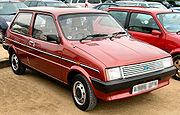
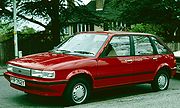
 The Austin Metro, launched in October 1980, was heralded as the saviour of Austin Motor Company and the whole BL combine. Twenty-one years after the launch of the Mini, it gave BL a much-needed modern supermini to compete with the recently launched likes of the Ford Fiesta
The Austin Metro, launched in October 1980, was heralded as the saviour of Austin Motor Company and the whole BL combine. Twenty-one years after the launch of the Mini, it gave BL a much-needed modern supermini to compete with the recently launched likes of the Ford Fiesta
, Vauxhall Chevette
and Renault 5
. It was an instant hit with buyers and was one of the most popular British cars of the 1980s. It was intended as a replacement for the Austin Mini but, in fact, the Mini outlived the Metro by two years.
In 1982, most of the car division of the by now somewhat shrunken British Leyland (BL) company was rebranded as the Austin Rover Group
, with Austin acting as the "budget" and mainstream brand to Rover's more luxurious models. The MG badge was revived for sporty versions of the Austin models, of which the MG Metro 1300 was the first.
Austin revitalised its entry into the small family-car market in March 1983 with the launch of its all-new Maestro
, a spacious five-door hatchback that replaced the elderly Allegro
and Maxi
and was popular in the early years of its production life, although sales had started to dip dramatically by the end of the decade.
April 1984 saw the introduction of the Maestro-derived Montego
saloon, successor to the Morris Ital
. The new car received praise for its interior space and comfort, but early build-quality problems took time to overcome. The spacious estate version, launched in early 1985, was one of the most popular load carriers of its era.
In 1986 Austin Rover's holding company BL plc became Rover Group plc
and was privatised by selling it to British Aerospace
(BAe).
Plans to replace the Metro with a radical new model, based on the ECV3 research vehicle and aiming for 100 mpg, led to the Austin AR6 of 1984–1986, with several prototypes tested. The desire to lose the Austin name and take Rover "upmarket" led to this project's demise in early 1987.
In 1987, the Austin badge was discontinued and Austin Rover became simply the Rover Group. The Austin cars continued to be manufactured, although they ceased to be Austins. They became "marque-less" in their home market with bonnet badges the same shape as the Rover longship badge but without "Rover" written on them. Instead any badging just showed the model of the car: a Montego of this era, for instance, would have a grille badge simply saying "Montego", whilst the rear badges just said "Montego" and the engine size/trim level. The Metro was facelifted in 1990 and got the new K-series
engine. It then became the "Rover Metro", while the Maestro and Montego continued in production until 1994 and never wore a Rover badge on their bonnets in Britain. They were, however, sometimes referred to as "Rovers" in the press and elsewhere.
and then to BMW when each bought the Rover Group. The rights were subsequently sold to MG Rover
, created when BMW sold the business. Following MG Rover's collapse and sale, Nanjing Automobile Group owns the Austin name and Austin's historic assembly plant in Longbridge. At the Nanjing International Exhibition in May 2006, Nanjing announced it might use the Austin name on some of the revived MG Rover models, at least in the Chinese market. However, Nanjing is for the moment concentrating on reviving the MG brand. The MG brand is traditionally used for sports cars and Nanjing has no rights to the Rover name, so a revival of the Austin name would seem a logical brand for selling more standard cars. It might also be argued that a British name would be more respected in the European market than a Chinese name.
, however Herbert Austin relocated to an abandoned paint works at Longbridge
, Birmingham. Due to its strategic advantages over Morris'
Cowley plant, Longbridge became British Leyland's main factory. Following the Austin marque's discontinuance in 1989, Rover and MG continued to use the plant. The collapse of MG Rover
meant it was not used from 2005 until MG production restarted in 2008.
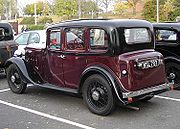
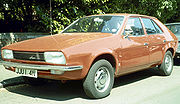



British Motor Corporation
The British Motor Corporation, or commonly known as BMC was a vehicle manufacturer from United Kingdom, formed by the merger of the Austin Motor Company and the Nuffield Organisation in 1952...
Ltd. The marque Austin was used until 1987. The trademark is currently owned by SAIC after being transferred from bankrupt subsidiary Nanjing Automotive.
History

1905–1918: Formation and development
Herbert AustinHerbert Austin, 1st Baron Austin
Herbert 'Pa' Austin, 1st Baron Austin KBE was an English automobile designer and builder who founded the Austin Motor Company.-Background and early life:...
(1866–1941), former manager of the Wolseley Tool and Motor Car Company
Wolseley Motor Company
The Wolseley Motor Company was a British automobile manufacturer founded in 1901. After 1935 it was incorporated into larger companies but the Wolseley name remained as an upmarket marque until 1975.-History:...
, and later to be made first Baron Austin of Longbridge, founded The Austin Motor Company in 1905, at Longbridge
Longbridge
Longbridge is an area of Birmingham, England. For local government purposes it is a ward within the district of Northfield.Since 1905, the area has been dominated by the Longbridge plant, which produced Austin, Nash Metropolitan, Morris, British Leyland, and most recently MG Rover cars...
, which was then in Worcestershire
Worcestershire
Worcestershire is a non-metropolitan county, established in antiquity, located in the West Midlands region of England. For Eurostat purposes it is a NUTS 3 region and is one of three counties that comprise the "Herefordshire, Worcestershire and Warwickshire" NUTS 2 region...
. (Longbridge became part of Birmingham
Birmingham
Birmingham is a city and metropolitan borough in the West Midlands of England. It is the most populous British city outside the capital London, with a population of 1,036,900 , and lies at the heart of the West Midlands conurbation, the second most populous urban area in the United Kingdom with a...
in 1911 when its boundaries were expanded.) The first car was a conventional 5-litre four-cylinder model with chain drive, of which about 200 were made in the first five years. In World War I Austin grew enormously in fulfilling government contracts for everything from artillery to aircraft, and the workforce expanded from around 2,500 to 22,000.
1919–1939: Interwar success



Receivership
In law, receivership is the situation in which an institution or enterprise is being held by a receiver, a person "placed in the custodial responsibility for the property of others, including tangible and intangible assets and rights." The receivership remedy is an equitable remedy that emerged in...
in 1921 but rose again after financial restructuring.
Critical to the recovery was the appointment in 1922 of a new finance director, Ernest Payton with the backing of the Midland Bank
Midland Bank
Midland Bank Plc was one of the Big Four banking groups in the United Kingdom for most of the 20th century. It is now part of HSBC. The bank was founded as the Birmingham and Midland Bank in Union Street, Birmingham, England in August 1836...
, and a new works director in charge of car production, Carl Engelbach, at the insistence of the creditors' committee. This triumvirate of Austin, Payton and Engelbach steered the company's fortunes through the inter-war years.
In a quest to expand market share, smaller cars were introduced, the 1661 cc Twelve in 1922 and, later the same year, the Seven
Austin 7
The Austin 7 was a car produced from 1922 through to 1939 in the United Kingdom by the Austin Motor Company. Nicknamed the "Baby Austin", it was one of the most popular cars ever produced for the British market, and sold well abroad...
, an inexpensive, simple small car and one of the earliest to be directed at a mass market. One of the reasons for a market demand for a cars like the Austin 7 was the British tax code. In 1930 every personal car was taxed by the engine size, which in American dollars was $2.55 per square inch of piston displacement. As an example the owner of an Austin 7 in England which sold for approximately $455.00 would had to pay a yearly engine tax of $39.00. In comparison the owner in England of a Ford Model-A would have to pay $120.00 per year in an engine tax. And this system of engine displacement tax was common in other European nations as well in the 1930s. At one point, the "Baby Austin" was built under licence by the fledgling BMW
BMW
Bayerische Motoren Werke AG is a German automobile, motorcycle and engine manufacturing company founded in 1916. It also owns and produces the Mini marque, and is the parent company of Rolls-Royce Motor Cars. BMW produces motorcycles under BMW Motorrad and Husqvarna brands...
of Germany (as the Dixi
BMW Dixi
The Dixi was the first car made by BMW.thumb|right|280px|1928 BMW DixiDixi was car brand of Eisenach car factory made from 1904; however, in the difficult climate of the 1920s the company found it hard to sell its 6/24 and 9/40 models...
); by the Japanese manufacturer Datsun
Datsun
Datsun was an automobile marque. The name was created in 1931 by the DAT Motorcar Co. for a new car model, spelling it as "Datson" to indicate its smaller size when compared to the existing, larger DAT car. Later, in 1933 after Nissan Motor Co., Ltd...
; as the Bantam
American Austin Car Company
The American Austin Car Company was a United States automobile manufacturing corporation tied to the British Austin Motor Company. The company was founded in 1929, and produced motorcars from 1930 through 1934, when it filed for bankruptcy....
in the United States; and as the Rosengart
Lucien Rosengart
Lucien Rosengart was a French engineer.His early life was shaped by carriages and the advance of the automobile age. He first started working as a mechanic at the age of 12, and by age 24 he had a machine shop in Belleville and several patents to his credit...
in France. And in England the Austin was the most produced car in 1930 (the American Austin Car Company
American Austin Car Company
The American Austin Car Company was a United States automobile manufacturing corporation tied to the British Austin Motor Company. The company was founded in 1929, and produced motorcars from 1930 through 1934, when it filed for bankruptcy....
operated as a largely independent subsidiary from 1929 to 1934, and was revived under the name "American Bantam" from 1937 to 1941).
With the help of the Seven, Austin weathered the worst of the depression and remained profitable through the 1930s, producing a wider range of cars which was steadily updated by the introduction of all-steel bodies, Girling brakes, and synchromesh gearboxes. However, all the engines retained the same side-valve conformation. Deputy chairman Ernest Payton became chairman in 1941 on the death of Lord Herbert Austin. In 1938 Leonard Lord
Leonard Lord
Leonard Percy Lord, 1st Baron Lambury KBE was a captain of the British motor industry.-Background and education:...
joined the company board and became chairman in 1946 on the death of Ernest Payton.


1939–1958: The war years and afterward
During the Second World War Austin continued building cars but also made trucks and aircraft, including the construction of the Lancaster bombers of 617 squadronNo. 617 Squadron RAF
No. 617 Squadron is a Royal Air Force aircraft squadron based at RAF Lossiemouth in Scotland. It currently operates the Tornado GR4 in the ground attack and reconnaissance role...
, better known as the Dambusters.
The postwar car range was announced in 1944 and production of it started in 1945
The immediate postwar range was mainly similar to that of the late 1930s but did include the 16 hp significant for having the company's first overhead valve
Overhead valve
An overhead valve engine, also informally called pushrod engine or I-head engine, is a type of piston engine that places the camshaft within the cylinder block , and uses pushrods or rods to actuate rocker arms above the cylinder...
engine.
In 1952 Austin merged with the Nuffield Organisation
Nuffield Organisation
The Nuffield Organisation was a vehicle manufacturing company in the United Kingdom. Named after its founder, William Morris, 1st Viscount Nuffield, it was formed in 1938 as the merger of Nuffield's Morris Motor Company , another of Nuffield's companies the MG Car Company and Riley.Morris Motors...
(parent company of Morris) to form the British Motor Corporation
British Motor Corporation
The British Motor Corporation, or commonly known as BMC was a vehicle manufacturer from United Kingdom, formed by the merger of the Austin Motor Company and the Nuffield Organisation in 1952...
with Leonard Lord in charge. Austin was the dominant partner and its engines were adopted for most of the cars; various models amongst the marques would soon be badge-engineered
Badge engineering
Badge engineering is an ironic term that describes the rebadging of one product as another...
versions of each other.
Also in 1952, Austin did a deal with Donald Healey, the renowned automotive engineer. It led to a new marque, Austin-Healey
Austin-Healey
Austin-Healey was a British sports car maker. The marque was established through a joint-venture arrangement, set up in 1952 between Leonard Lord of the Austin division of the British Motor Corporation and the Donald Healey Motor Company, a renowned automotive engineering and design...
, and a range of sports cars.
Legal agreement with Nissan
In 1952 Austin entered into a legal agreement with the Nissan Motor CompanyNissan Motors
, usually shortened to Nissan , is a multinational automaker headquartered in Japan. It was a core member of the Nissan Group, but has become more independent after its restructuring under Carlos Ghosn ....
of Japan, for that company to assemble 2000 imported Austins from partially assembled sets and to sell them in Japan under the Austin trademark. The agreement called for Nissan to make all Austin parts locally within three years, a goal Nissan met. Nissan produced and marketed Austins for seven years. The agreement also gave Nissan rights to use Austin patents, which Nissan used in developing its own engines for its Datsun
Datsun
Datsun was an automobile marque. The name was created in 1931 by the DAT Motorcar Co. for a new car model, spelling it as "Datson" to indicate its smaller size when compared to the existing, larger DAT car. Later, in 1933 after Nissan Motor Co., Ltd...
line of cars. In 1953 British-built Austins were assembled and sold, but by 1955, the Austin A50 – completely built by Nissan and featuring a slightly larger body with 1489 cc engine – was on the market in Japan. Nissan produced 20,855 Austins from 1953–59.
1959–1969: An era of revolution

Suez Crisis
The Suez Crisis, also referred to as the Tripartite Aggression, Suez War was an offensive war fought by France, the United Kingdom, and Israel against Egypt beginning on 29 October 1956. Less than a day after Israel invaded Egypt, Britain and France issued a joint ultimatum to Egypt and Israel,...
Lord asked Alec Issigonis
Alec Issigonis
Sir Alexander Arnold Constantine Issigonis, CBE, FRS was a Greek-British designer of cars, now remembered chiefly for the groundbreaking and influential development of the Mini, launched by the British Motor Corporation in 1959.- Early life:Issigonis was born into the Greek community of Smyrna ...
to design a small car and the result was the revolutionary Mini
Mini
The Mini is a small car that was made by the British Motor Corporation and its successors from 1959 until 2000. The original is considered a British icon of the 1960s, and its space-saving front-wheel-drive layout influenced a generation of car-makers...
, launched in 1959. The Austin version was called the Austin Seven at first. But Morris' Mini Minor name caught the public imagination and the Morris version outsold its Austin twin, so the Austin's name was changed to Mini to follow suit. In 1970, British Leyland dropped the separate Austin and Morris branding of the Mini. From then, it was simply "Mini", under the Austin Morris division of BLMC.
The principle of a transverse engine with gearbox in the sump and driving the front wheels was carried on to larger cars with the 1100 of 1963, (although the Morris-badged version was launched 13 months earlier than the Austin, in August 1962), the 1800
Austin 1800
BMC ADO17 was the model code used by the British Motor Corporation for a range of cars produced from September 1964 to 1975 and sold initially under its Austin marque as the Austin 1800. The car was also sold as the Morris 1800 and Wolseley 18/85, and later as the Austin 2200, Morris 2200 and...
of 1964 and the Maxi
Austin Maxi
The Austin Maxi was a medium sized 5-door hatchback car from British Leyland for the 1970s. It was the first British five speed five-door hatchback.-History:...
of 1969. This meant that BMC had spent 10 years developing a new range of front-drive, transverse-engined models, while most competitors had only just started to make such changes.
The big exception to this was the Austin 3-litre
Austin 3-Litre
The Austin 3-Litre was a British saloon car introduced by British Leyland at the London Motor Show in 1967. However, it subsequently became apparent that BMC were not geared up to producing the car: few or none seem to have been sold that year, but by July 1968 it was reported that the cars had...
. Launched in 1968, it was a rear-wheel drive large car, but it shared the central section of the 1800. It was a sales disaster, with fewer than 10,000 examples being made.
But BMC was the first British manufacturer to move into front-wheel drive so comprehensively. Ford
Ford Motor Company
Ford Motor Company is an American multinational automaker based in Dearborn, Michigan, a suburb of Detroit. The automaker was founded by Henry Ford and incorporated on June 16, 1903. In addition to the Ford and Lincoln brands, Ford also owns a small stake in Mazda in Japan and Aston Martin in the UK...
did not launch its first front-drive model until 1976(in Britain, Ford-Germany in 1962 with the Taunus 12M(P4)), while Vauxhall's
Vauxhall Motors
Vauxhall Motors is a British automotive company owned by General Motors and headquartered in Luton. It was founded in 1857 as a pump and marine engine manufacturer, began manufacturing cars in 1903 and was acquired by GM in 1925. It has been the second-largest selling car brand in the UK for...
first front-drive model was launched in 1979 and Chrysler UK's
Chrysler Europe
Chrysler Europe was a division of the Chrysler Corporation that operated between 1967 and 1979.-Formation:In the 1960s, Chrysler sought to become a world producer of automobiles. The company had never had much success outside North America, contrasting with Ford's worldwide reach and General...
first such car was launched in 1975. Front-wheel drive was popular elsewhere in Europe, however, with Renault
Renault
Renault S.A. is a French automaker producing cars, vans, and in the past, autorail vehicles, trucks, tractors, vans and also buses/coaches. Its alliance with Nissan makes it the world's third largest automaker...
, Citroen
Citroën
Citroën is a major French automobile manufacturer, part of the PSA Peugeot Citroën group.Founded in 1919 by French industrialist André-Gustave Citroën , Citroën was the first mass-production car company outside the USA and pioneered the modern concept of creating a sales and services network that...
and Simca
Simca
Simca was a French automaker, founded in November 1934 by Fiat. It was directed from July 1935 to May 1963 by the Italian Henri Théodore Pigozzi...
all using the system at the same time or before BMC.
In 1966, BMC and Pressed Steel
Pressed Steel Company
The Pressed Steel Company Limited was a British car body manufacturing company founded at Cowley near Oxford in 1926 as a joint venture between William Morris, the Budd Corporation and an American bank. Today at what was the company's Cowley plant, the BMW new MINI is assembled, this site is...
merged with Jaguar and became British Motor Holdings
British Motor Holdings
British Motor Holdings Limited was a British motor company known until 14 December 1966 as British Motor Corporation Limited .-History:...
. In 1968, BMH merged with Leyland Motors
Leyland Motors Ltd
Leyland Motors Limited was a British vehicle manufacturer of lorries, buses and trolleybuses. It gave its name to the British Leyland Motor Corporation formed when it merged with British Motor Holdings, later to become British Leyland after being nationalised...
and Austin became a part of the big British Leyland Motor Corporation (BLMC) combine.
1970–1979: An era of turbulence
By 1970 Austin was part of the British Leyland combine, which produced some of the most maligned cars ever to roll off British production lines. Austin's most notorious model of this era was the 1973 AllegroAustin Allegro
The Austin Allegro is a small family car manufactured by British Leyland under the Austin name from 1973 until 1983. The same vehicle was built in Italy by Innocenti between 1974 and 1975 and sold as the Innocenti Regent...
, successor to the 1100/1300 ranges, which was criticised for its bulbous styling, doubtful build quality, indifferent reliability, and rust-proneness. It was still a strong seller in Britain, although not quite as successful as its predecessor.
The wedge-shaped 18/22
Leyland Princess
The Princess is a family car that was produced in the United Kingdom by British Leyland from 1975 until 1981. The car inherited a front-wheel drive / transverse engine configuration from its predecessor, the BMC ADO17 range...
series was launched as an Austin, a Morris and a more upmarket Wolseley in 1975. But within six months, it was rechristened the Princess and wore none of the previous marque badges, becoming a kind of brand in its own right, under the Austin Morris division of British Leyland which had been virtually nationalised in 1975.
The Princess was not quite as notorious as the Allegro, and in fact earned some praise thanks to its practical wedge shape, spacious interior and decent ride and handling, but build quality was suspect and the curious lack of a hatchback (which would have ideally suited its body shape) cost it valuable sales. It was upgraded at the end of 1981 to become the Ambassador
Austin Ambassador
The Austin Ambassador was a medium-to-large hatchback car model introduced by British Leyland in 1982. The vehicle was a heavily updated version of the Princess, an ageing model that had lacked a hatchback...
(and gaining a hatchback) but by this time there was little that could be done to disguise the age of the design, and it was too late to make much of an impact on sales.
By the end of the 1970s, the future of Austin and the rest of British Leyland (now known as BL) was looking bleak.
1980–1989: The Austin Rover era



Ford Fiesta
The Ford Fiesta is a front wheel drive supermini/subcompact manufactured and marketed by Ford Motor Company and built in Europe, Brazil, Argentina, Mexico, Venezuela, China, India, Thailand and South Africa...
, Vauxhall Chevette
Vauxhall Chevette
The Chevette was a supermini model of car manufactured by Vauxhall in the UK from 1975 to 1984. It was Vauxhall's version of the family of small "T-Cars" from Vauxhall's parent General Motors ; the family included the Opel Kadett in Germany, the Isuzu Gemini in Japan, the Holden Gemini in...
and Renault 5
Renault 5
The Renault 5 was first unveiled on 10 December 1971, being launched at the beginning of 1972.The Renault 5 was styled by Michel Boué, who died before the car's release, the R5 featured a steeply sloping rear hatchback and front dashboard...
. It was an instant hit with buyers and was one of the most popular British cars of the 1980s. It was intended as a replacement for the Austin Mini but, in fact, the Mini outlived the Metro by two years.
In 1982, most of the car division of the by now somewhat shrunken British Leyland (BL) company was rebranded as the Austin Rover Group
Austin Rover Group
The Austin Rover Group was a British motor manufacturer. It was formed in 1981 as the mass-market car manufacturing subsidiary of British Leyland...
, with Austin acting as the "budget" and mainstream brand to Rover's more luxurious models. The MG badge was revived for sporty versions of the Austin models, of which the MG Metro 1300 was the first.
Austin revitalised its entry into the small family-car market in March 1983 with the launch of its all-new Maestro
Austin Maestro
The Austin Maestro is a compact-sized 5-door hatchback car that was produced from 1983 to 1994, initially by the Austin Rover subsidiary of British Leyland , and from 1988 onwards by its successor, Rover Group. The car was produced at the former Morris plant in Cowley, Oxford. It was initially...
, a spacious five-door hatchback that replaced the elderly Allegro
Austin Allegro
The Austin Allegro is a small family car manufactured by British Leyland under the Austin name from 1973 until 1983. The same vehicle was built in Italy by Innocenti between 1974 and 1975 and sold as the Innocenti Regent...
and Maxi
Austin Maxi
The Austin Maxi was a medium sized 5-door hatchback car from British Leyland for the 1970s. It was the first British five speed five-door hatchback.-History:...
and was popular in the early years of its production life, although sales had started to dip dramatically by the end of the decade.
April 1984 saw the introduction of the Maestro-derived Montego
Austin Montego
The Austin Montego is a British mid-size saloon car that was produced by the Austin Rover subsidiary of British Leyland , and its successors, from 1984 until 1994. The Montego was the replacement for the Morris Ital, to give British Leyland a modern competitor for the Ford Sierra and Vauxhall...
saloon, successor to the Morris Ital
Morris Ital
The Morris Ital was a medium-sized saloon car built by British Leyland from 1980 until 1984.-Design and launch:The Ital was first launched on 1 July 1980. It took its name from Giorgetto Giugiaro's ItalDesign studio, who had been employed by BL to manage the re-engineering of Morris Marina, a car...
. The new car received praise for its interior space and comfort, but early build-quality problems took time to overcome. The spacious estate version, launched in early 1985, was one of the most popular load carriers of its era.
In 1986 Austin Rover's holding company BL plc became Rover Group plc
Rover Group
The Rover Group plc was the name given in 1986 to the British state-owned vehicle manufacturer previously known as British Leyland or BL. Owned by British Aerospace from 1988 to 1994, when it was sold to BMW, the Group was broken up in 2000 with the Rover and MG marques being acquired by the MG...
and was privatised by selling it to British Aerospace
British Aerospace
British Aerospace plc was a UK aircraft, munitions and defence-systems manufacturer. Its head office was in the Warwick House in the Farnborough Aerospace Centre in Farnborough, Hampshire...
(BAe).
Plans to replace the Metro with a radical new model, based on the ECV3 research vehicle and aiming for 100 mpg, led to the Austin AR6 of 1984–1986, with several prototypes tested. The desire to lose the Austin name and take Rover "upmarket" led to this project's demise in early 1987.
In 1987, the Austin badge was discontinued and Austin Rover became simply the Rover Group. The Austin cars continued to be manufactured, although they ceased to be Austins. They became "marque-less" in their home market with bonnet badges the same shape as the Rover longship badge but without "Rover" written on them. Instead any badging just showed the model of the car: a Montego of this era, for instance, would have a grille badge simply saying "Montego", whilst the rear badges just said "Montego" and the engine size/trim level. The Metro was facelifted in 1990 and got the new K-series
Rover K engine
The K-Series engine is a series of engines built by Powertrain Ltd, a sister company of MG Rover. The engine was built in two forms: a straight-four cylinder, available with SOHC and DOHC, ranging from 1.1 L to 1.8 L; and the KV6 V6 variation....
engine. It then became the "Rover Metro", while the Maestro and Montego continued in production until 1994 and never wore a Rover badge on their bonnets in Britain. They were, however, sometimes referred to as "Rovers" in the press and elsewhere.
Possible revival
The rights to the Austin name passed to British AerospaceBritish Aerospace
British Aerospace plc was a UK aircraft, munitions and defence-systems manufacturer. Its head office was in the Warwick House in the Farnborough Aerospace Centre in Farnborough, Hampshire...
and then to BMW when each bought the Rover Group. The rights were subsequently sold to MG Rover
MG Rover Group
MG Rover was the last domestically owned mass-production car manufacturer in the British motor industry. The company was formed when BMW sold the car-making and engine manufacturing assets of the original Rover Group to the Phoenix Consortium in 2000....
, created when BMW sold the business. Following MG Rover's collapse and sale, Nanjing Automobile Group owns the Austin name and Austin's historic assembly plant in Longbridge. At the Nanjing International Exhibition in May 2006, Nanjing announced it might use the Austin name on some of the revived MG Rover models, at least in the Chinese market. However, Nanjing is for the moment concentrating on reviving the MG brand. The MG brand is traditionally used for sports cars and Nanjing has no rights to the Rover name, so a revival of the Austin name would seem a logical brand for selling more standard cars. It might also be argued that a British name would be more respected in the European market than a Chinese name.
Plant
Austin's original plant was in RotherhamRotherham
Rotherham is a town in South Yorkshire, England. It lies on the River Don, at its confluence with the River Rother, between Sheffield and Doncaster. Rotherham, at from Sheffield City Centre, is surrounded by several smaller settlements, which together form the wider Metropolitan Borough of...
, however Herbert Austin relocated to an abandoned paint works at Longbridge
Longbridge
Longbridge is an area of Birmingham, England. For local government purposes it is a ward within the district of Northfield.Since 1905, the area has been dominated by the Longbridge plant, which produced Austin, Nash Metropolitan, Morris, British Leyland, and most recently MG Rover cars...
, Birmingham. Due to its strategic advantages over Morris'
Morris Motor Company
The Morris Motor Company was a British car manufacturing company. After the incorporation of the company into larger corporations, the Morris name remained in use as a marque until 1984 when British Leyland's Austin Rover Group decided to concentrate on the more popular Austin marque...
Cowley plant, Longbridge became British Leyland's main factory. Following the Austin marque's discontinuance in 1989, Rover and MG continued to use the plant. The collapse of MG Rover
MG Rover Group
MG Rover was the last domestically owned mass-production car manufacturer in the British motor industry. The company was formed when BMW sold the car-making and engine manufacturing assets of the original Rover Group to the Phoenix Consortium in 2000....
meant it was not used from 2005 until MG production restarted in 2008.
Cars


- Small carsSubcompact carSubcompact car is a North American term used to describe automobiles whose class size is smaller than that of a compact car, usually not exceeding in length, but larger than a microcar...
- 1910–11 Austin 7 hp
- 1922–39 Austin 7Austin 7The Austin 7 was a car produced from 1922 through to 1939 in the United Kingdom by the Austin Motor Company. Nicknamed the "Baby Austin", it was one of the most popular cars ever produced for the British market, and sold well abroad...
- 1959–2000 Seven (Mini)MiniThe Mini is a small car that was made by the British Motor Corporation and its successors from 1959 until 2000. The original is considered a British icon of the 1960s, and its space-saving front-wheel-drive layout influenced a generation of car-makers...
, as BMC - 1980–90 MetroRover MetroThe Metro is a supermini car that was produced by the Austin Rover Group division of British Leyland and its successors. It was launched in 1980 as the Austin miniMetro. It was intended to complement the Mini, and was developed under the codename LC8....
, as Austin Rover
- Small family carsCompact carA compact car , or small family car , is a classification of cars which are larger than a supermini but smaller than or equal to a mid-size car...
- 1911–15 Austin 10
- 1932–47 Austin 10 hp
- 1939–47 Austin 8 hpAustin 8The Austin 8 was a small car made by the Austin Motor Company. Launched in 1939 and produced into the war , about 9,000 of the wartime Austin 8 models were two-seater tourers produced for the military and government, and the rest were saloons...
- 1951–56 A30Austin A30The A30 was a compact car produced by Austin Motor Company in the 1950s. Introduced in 1951 as the "New Austin Seven", it was Austin's answer to the Morris Minor...
- 1956–59 A35Austin A35The A35 was a small car sold by the British Motor Corporation under the Austin marque in the 1950s.-Design:Introduced in 1956, it replaced the highly successful Austin A30...
- 1956–62 A35 CountrymanAustin A35The A35 was a small car sold by the British Motor Corporation under the Austin marque in the 1950s.-Design:Introduced in 1956, it replaced the highly successful Austin A30...
- 1954–61 Nash MetropolitanNash MetropolitanThe Nash Metropolitan is a car that was sold, initially only in the United States and Canada, from 1954–1962.It conforms to two classes of vehicle: economy car and subcompact car. In today’s terminology the Metropolitan is a “subcompact”, but this category had not yet come into use when the car was...
/Austin MetropolitanNash MetropolitanThe Nash Metropolitan is a car that was sold, initially only in the United States and Canada, from 1954–1962.It conforms to two classes of vehicle: economy car and subcompact car. In today’s terminology the Metropolitan is a “subcompact”, but this category had not yet come into use when the car was... - 1958–61 A40 Farina Mk IAustin A40 FarinaThe Austin A40 Farina was a compact car introduced by the British Motor Corporation in 1958, replacing the earlier A40 Devon.It combines many of the virtues of a saloon and estate car in one body. There is more headroom for the rear passengers because of the angular instead of curved lines of the...
- 1961–67 A40 Farina Mk IIAustin A40 FarinaThe Austin A40 Farina was a compact car introduced by the British Motor Corporation in 1958, replacing the earlier A40 Devon.It combines many of the virtues of a saloon and estate car in one body. There is more headroom for the rear passengers because of the angular instead of curved lines of the...
- 1963–74 1100BMC ADO16ADO16 is the codename for the development of what became the Morris 1100, a small family car built by the British Motor Corporation and, later, British Leyland...
- 1967–74 1300BMC ADO16ADO16 is the codename for the development of what became the Morris 1100, a small family car built by the British Motor Corporation and, later, British Leyland...
- 1973–83 AllegroAustin AllegroThe Austin Allegro is a small family car manufactured by British Leyland under the Austin name from 1973 until 1983. The same vehicle was built in Italy by Innocenti between 1974 and 1975 and sold as the Innocenti Regent...
- Large family cars
- 1906–07 Austin 25/30
- 1907–10 Austin 18/24
- 1908–11 Austin 40 hp
- 1908–10 Austin 60 hp
- 1913–14 Austin 15/20
- 1914–16 Austin 30 hp
- 1919–30 Austin TwentyAustin TwentyThe Austin Twenty was introduced by the Austin Motor Company in 1919 continuing in production until 1930. After the 20/6 model was introduced in 1927, the car was known as the Austin 20/4....
- 1922–40 Austin "Heavy" 12Austin 12 hpThe Austin 12/4 was introduced by the Austin Motor Company in 1921. It was the second of Herbert Austin's post World War I models and was in many ways a scaled-down version of the 20/4, introduced in 1919...
- 1927–35 16/18 hpAustin 16The Austin 16 was a British car made by the Austin Motor Company between 1927 and 1936. The "16" name was re-used in the post war Austin 16 hp....
- 1927–39 Austin 20/6
- 1931–36 Austin "Light" 12/6Austin 12/6The Austin 12/6 was introduced by the Austin Motor Company in 1931 continuing in production until 1937. To separate it from the earlier, four-cylinder, Austin 12, it has become known as the Austin Light 12/6....
- 1933–39 Austin "Light" 12/4Austin 12/4The Austin 12/4 was a car produced by the Austin Motor Company from 1933 until 1939. To distinguish it from the earlier four-cylinder Austin 12 it has become known as the Austin Light 12/4. It was replaced in 1939 by a new model also called the Austin 12 keeping the same engine...
- 1937–39 Austin 14 hp
- 1938–39 Austin 18 hp
- 1939–47 Austin 12Austin 12 (1939)The Austin 12 was a large four door family saloon produced by the Austin Motor Company. It was launched in August 1939 and was produced until replaced in 1947 by the similar sized but larger engined Austin A70 Hampshire. For much of this period, however, it was provided only for military and...
- 1945–49 Austin 16 hpAustin 16 hpthumb|right|280px|1946 Austin Sixteen BS1, The 1 millionth Austin producedThe Austin 16HP was the first 'new' car to be produced by the Austin Motor Company following the Second World War...
- 1947–52 A40 Devon/DorsetAustin A40 DevonThe A40 Devon were automobiles marketed by the Austin Motor Company from 1947 to 1952 – the first post-war saloons to be produced by Austin – featuring a mix of old and new technologies...
- 1948–50 A70 HampshireAustin A70The Austin A70 Hampshire and later Austin A70 Hereford are large cars which were produced by the Austin Motor Company of Britain from 1948 until 1954...
- 1950–54 A70 HerefordAustin A70The Austin A70 Hampshire and later Austin A70 Hereford are large cars which were produced by the Austin Motor Company of Britain from 1948 until 1954...
- 1952–54 A40 SomersetAustin A40 SomersetThe A40 Somerset is an automobile sold by the Austin Motor Company from 1952 until 1954. It replaced the A40 Devon and was quite similar to that body-on-frame car, including using the same 1.2 L straight-4 pushrod engine...
- 1954–58 A40/A50/A55 CambridgeAustin CambridgeThe Austin Cambridge is a motor car range sold by the Austin Motor Company in several generations from September 1954 through to 1969 as cars and 1971 as light commercials. It replaced the A40 Somerset but was entirely new with modern unibody construction...
- 1954–59 A90/A95/A105 WestminsterAustin WestminsterThe Westminster series were large saloon and estate cars sold by the British Austin Motor Company from 1954, replacing the A70 Hereford. The Westminster line was produced as the A90, A95, A99, A105, and A110 until 1968 when the new Austin 3-Litre took its place...
- 1956–59 A95 WestminsterAustin WestminsterThe Westminster series were large saloon and estate cars sold by the British Austin Motor Company from 1954, replacing the A70 Hereford. The Westminster line was produced as the A90, A95, A99, A105, and A110 until 1968 when the new Austin 3-Litre took its place...
Station wagon. - 1956–59 A105 WestminsterAustin WestminsterThe Westminster series were large saloon and estate cars sold by the British Austin Motor Company from 1954, replacing the A70 Hereford. The Westminster line was produced as the A90, A95, A99, A105, and A110 until 1968 when the new Austin 3-Litre took its place...
- 1959–61 A55 CambridgeAustin CambridgeThe Austin Cambridge is a motor car range sold by the Austin Motor Company in several generations from September 1954 through to 1969 as cars and 1971 as light commercials. It replaced the A40 Somerset but was entirely new with modern unibody construction...
- 1959–61 A99 WestminsterAustin WestminsterThe Westminster series were large saloon and estate cars sold by the British Austin Motor Company from 1954, replacing the A70 Hereford. The Westminster line was produced as the A90, A95, A99, A105, and A110 until 1968 when the new Austin 3-Litre took its place...
- 1961–69 A60 CambridgeAustin CambridgeThe Austin Cambridge is a motor car range sold by the Austin Motor Company in several generations from September 1954 through to 1969 as cars and 1971 as light commercials. It replaced the A40 Somerset but was entirely new with modern unibody construction...
- 1961–68 A110 WestminsterAustin WestminsterThe Westminster series were large saloon and estate cars sold by the British Austin Motor Company from 1954, replacing the A70 Hereford. The Westminster line was produced as the A90, A95, A99, A105, and A110 until 1968 when the new Austin 3-Litre took its place...
- 1964–75 1800/2200
- 1967–71 3-LitreAustin 3-LitreThe Austin 3-Litre was a British saloon car introduced by British Leyland at the London Motor Show in 1967. However, it subsequently became apparent that BMC were not geared up to producing the car: few or none seem to have been sold that year, but by July 1968 it was reported that the cars had...
- 1969–81 Maxi 1500Austin MaxiThe Austin Maxi was a medium sized 5-door hatchback car from British Leyland for the 1970s. It was the first British five speed five-door hatchback.-History:...
- 1975–84 18-22/Princess/AmbassadorAustin AmbassadorThe Austin Ambassador was a medium-to-large hatchback car model introduced by British Leyland in 1982. The vehicle was a heavily updated version of the Princess, an ageing model that had lacked a hatchback...
- 1983–94 MaestroAustin MaestroThe Austin Maestro is a compact-sized 5-door hatchback car that was produced from 1983 to 1994, initially by the Austin Rover subsidiary of British Leyland , and from 1988 onwards by its successor, Rover Group. The car was produced at the former Morris plant in Cowley, Oxford. It was initially...
- 1984–94 MontegoAustin MontegoThe Austin Montego is a British mid-size saloon car that was produced by the Austin Rover subsidiary of British Leyland , and its successors, from 1984 until 1994. The Montego was the replacement for the Morris Ital, to give British Leyland a modern competitor for the Ford Sierra and Vauxhall...
- LimousineLimousineA limousine is a luxury sedan or saloon car, especially one with a lengthened wheelbase or driven by a chauffeur. The chassis of a limousine may have been extended by the manufacturer or by an independent coachbuilder. These are called "stretch" limousines and are traditionally black or white....
s- 1939 Austin 28 hp
- 1947–54 A110/A125 SheerlineAustin SheerlineThe Austin Sheerline was a luxury car produced by Austin Motor Company from 1947 to 1954.The Sheerline was designed by Austin during World War Two but production did not begin until 1947 because of the commitment to war production...
- 1946–56 A120 PrincessAustin PrincessThe Princess was a distinctive series of large luxury cars made by Austin and its subsidiary Vanden Plas from 1947 to 1968. However:The Princess name was later also used as follows:...
- 1947–56 A135 PrincessAustin PrincessThe Princess was a distinctive series of large luxury cars made by Austin and its subsidiary Vanden Plas from 1947 to 1968. However:The Princess name was later also used as follows:...
- 1956–59 Princess IVAustin PrincessThe Princess was a distinctive series of large luxury cars made by Austin and its subsidiary Vanden Plas from 1947 to 1968. However:The Princess name was later also used as follows:...
- 1958–59 A105 Westminster Vanden PlasAustin WestminsterThe Westminster series were large saloon and estate cars sold by the British Austin Motor Company from 1954, replacing the A70 Hereford. The Westminster line was produced as the A90, A95, A99, A105, and A110 until 1968 when the new Austin 3-Litre took its place...
- Sports carSports carA sports car is a small, usually two seat, two door automobile designed for high speed driving and maneuverability....
s- 1920–23 Austin 20 Sports Tourer
- 1948–50 A90 Atlantic ConvertibleAustin AtlanticThe Austin A90 Atlantic was a British car produced by the Austin Motor Company, launched initially as a sporting four seat convertible. It made its début at the 1948 Earls Court Motor Show in London, with production models built between spring 1949 and late 1950...
- 1949–52 A90 Atlantic SaloonAustin AtlanticThe Austin A90 Atlantic was a British car produced by the Austin Motor Company, launched initially as a sporting four seat convertible. It made its début at the 1948 Earls Court Motor Show in London, with production models built between spring 1949 and late 1950...
- 1950–53 A40 SportsAustin A40 SportsSee Austin A40 for other A40 models.The Austin A40 Sports debuted at the 1949 London Motor Show as a four-passenger, aluminium-bodied convertible version of the Austin A40 — carrying an Austin of England nameplate, bearing the marque's Flying A hood ornament, and designed and manufactured in...
- 1953–56 Austin-Healey 100Austin-Healey 100The Austin-Healey 100 is a sports car built from 1953 until 1959. There were two models, the original four-cylinder Austin-Healey 100, built 1953-1956, and the six-cylinder Austin-Healey 100-6, built 1956-1959....
- 1958–70 Austin-Healey SpriteAustin-Healey SpriteThe Austin-Healey Sprite is a small open sports car which was announced to the press in Monte Carlo by the British Motor Corporation on 20 May 1958, just before that year's Monaco Grand Prix. It was intended to be a low-cost model that "a chap could keep in his bike shed", yet be the successor to...
- 1959–67 Austin-Healey 3000Austin-Healey 3000The Austin-Healey 3000 is a British sports car built from 1959 to 1967, and is the best known of the "big" Healey models. The car's bodywork was made by Jensen Motors, and the vehicles were assembled at the BMC Abingdon works....
- 1971 Austin SpriteAustin-Healey SpriteThe Austin-Healey Sprite is a small open sports car which was announced to the press in Monte Carlo by the British Motor Corporation on 20 May 1958, just before that year's Monaco Grand Prix. It was intended to be a low-cost model that "a chap could keep in his bike shed", yet be the successor to...
- Australian Austin cars
- 1962–66 Austin FreewayAustin FreewayThe Austin Freeway is an automobile which was developed by the Australian division of the British Motor Corporation , based on the British Austin A60 Cambridge...
- 1970–73 Austin KimberleyAustin KimberleyThe Australian Austin Kimberley and Austin Tasman "X6" models of 1970 were a range of Leyland Australian designed front-wheel-drive sedans based on the Austin 1800 platform...
- 1958–62 Austin Lancer
- 1970–73 Austin Tasman
- 1962–66 Austin Freeway
Military vehicles
- WWI Austin Armoured CarAustin Armoured CarAustin Armoured Car was a British armoured car produced during the First World War. The vehicle is best known for its employment by the Russian Army in the First World War and by different forces in the Russian Civil War....
- WWII Austin Ten Utility Truck
- WWII Austin K2Austin K2The Austin K2/Y was a British heavy military ambulance built by the Austin Motor Company for use during the Second World War.The rear body, built by Mann Egerton, could take ten casualties sitting or four stretcher cases...
- WWII Austin K4
- 1958–67 Austin GipsyAustin GipsyThe Austin Gipsy was Austin's attempt at an off-road capable vehicle to compete with Rover's Land Rover.-History:Austin picked the name with an "I" spelling rather than gypsy....
- Austin ChampAustin ChampThe Austin Champ was the civilian version of a British Army vehicle made by the Austin Motor Company. The army version was officially known as "Truck, 1/4 ton, CT, 4x4, cargo & FFW, Austin Mk.1" however the civilian name "Champ" was universally, if unofficially, applied to it.- History :A British...
- c. 1968 Austin AntAustin AntThe Austin Ant was a small four-wheel drive vehicle designed by Sir Alec Issigonis for the motor manufacturer British Motor Corporation . Although the Ant is widely regarded as a military vehicle, some sources suggest it was conceived with civilian use in mind as well...
Taxis
- 1929–34 High Lot
- 1934–39 Lowloader
- 1948–58 FX3
- 1958– FX4Austin FX4The FX4 is the classic Black Cab. While the majority are black, there is in fact no requirement for them, or indeed any other make of London taxi to be black. Over the years, the FX4 has been sold under a number of different makers' names.-Design and launch:...
—London Taxi
Commercial vehicles



- Austin also made commercial vehicles, one of which was the FG, previously the Morris FG. The FG was the workhorse that kept Britain running in the 1960s. These Austin FGs and later the Leyland FGs all had petrol or diesel longstroke engines, producing good torque, but very little in the way of speed (40 mph was a good speed out of these vehicles). Leyland were to take over the FG, but before they did, in 1964, the BBC (British Broadcasting Corporation) commissioned six rolling chassis FGs to be coach built by a Middlesex company, Palmer Coachbuilders. These six vehicles, registration 660 GYE to 666 GYE, were outdoor broadcast scenery vehicles.
Aircraft
During World War I Austin built aircraft under licence, including the Royal Aircraft Factory S.E.5a, but also produced a number of its own designs. None of these progressed past the prototype stage. They included:- Austin-Ball A.F.B.1Austin-Ball A.F.B.1-See also:...
(fighter) - Austin A.F.T.3 (fighter)
- Austin GreyhoundAustin Greyhound|-See also:-External links:*...
(fighter) - Austin KestrelAustin Kestrel-External links:*...
(two-seat biplane) - Austin OspreyAustin Osprey|-See also:-References:*Bruce, J.M. British Aeroplanes 1914-18. London:Putnam, 1957.*Bruce, J.M. War Planes of the First World War:Volume One: Fighters. London:Macdonald, 1965....
(fighter) - Austin WhippetAustin Whippet-References:* "". Flight, 14 August 1919. Vol. XI, no. 33, pp. 1076–1078. Technical description with photographs and scale drawings.* "". Flight, 15 July 1920. pp.749-780....
(post-war civil aircraft)
External links
- Austin Memories All about the history of Longbridge and models produced
- Photos of Austin Pickup Van
- The Unofficial Austin-Rover Web Resource
- American Austin Car Enthusiasts
- Austin Champ Owners Club
- "Midget Cars Next?" Popular Mechanics, August 1930, pp 243-245 article on the Austin models offered in 1930

